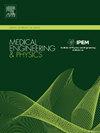Fluid-structure interaction simulations for the prediction of fractional flow reserve in pediatric patients with anomalous aortic origin of a coronary artery
IF 1.7
4区 医学
Q3 ENGINEERING, BIOMEDICAL
引用次数: 0
Abstract
Computer simulations of blood flow in patients with anomalous aortic origin of a coronary artery (AAOCA) have the promise to provide insight into this complex disease. They provide an in silico experimental platform to explore possible mechanisms of myocardial ischemia, a potentially deadly complication for patients with this defect. This paper focuses on the question of model calibration for fluid-structure interaction models of pediatric AAOCA patients. Imaging and cardiac catheterization data provide partial information for model construction and calibration. However, parameters for downstream boundary conditions needed for these models are difficult to estimate. Further, important model predictions, like fractional flow reserve (FFR), are sensitive to these parameters. We describe an approach to calibrate downstream boundary condition parameters to clinical measurements of resting FFR. The calibrated models are then used to predict FFR at stress, an invasively measured quantity that can be used in the clinical evaluation of these patients. We find reasonable agreement between the model predicted and clinically measured FFR at stress, indicating the credibility of this modeling framework for predicting hemodynamics of pediatric AAOCA patients. This approach could lead to important clinical applications since it may serve as a tool for risk stratifying children with AAOCA.
流固相互作用模拟预测冠状动脉异常起源地患儿血流储备分数
冠状动脉异常起源(AAOCA)患者的血流计算机模拟有望提供对这种复杂疾病的深入了解。他们提供了一个计算机实验平台来探索心肌缺血的可能机制,心肌缺血是心肌缺损患者潜在的致命并发症。本文主要研究小儿AAOCA患者流固耦合模型的模型标定问题。成像和心导管数据为模型构建和校准提供了部分信息。然而,这些模型所需的下游边界条件参数很难估计。此外,重要的模型预测,如分数流量储备(FFR),对这些参数很敏感。我们描述了一种校准静息FFR临床测量的下游边界条件参数的方法。然后使用校准的模型来预测压力下的FFR,这是一个可用于这些患者临床评估的侵入性测量量。我们发现模型预测的压力下FFR与临床测量的FFR之间存在合理的一致性,表明该模型框架预测儿科AAOCA患者血流动力学的可信度。这种方法可能会导致重要的临床应用,因为它可以作为对AAOCA儿童进行风险分层的工具。
本文章由计算机程序翻译,如有差异,请以英文原文为准。
求助全文
约1分钟内获得全文
求助全文
来源期刊

Medical Engineering & Physics
工程技术-工程:生物医学
CiteScore
4.30
自引率
4.50%
发文量
172
审稿时长
3.0 months
期刊介绍:
Medical Engineering & Physics provides a forum for the publication of the latest developments in biomedical engineering, and reflects the essential multidisciplinary nature of the subject. The journal publishes in-depth critical reviews, scientific papers and technical notes. Our focus encompasses the application of the basic principles of physics and engineering to the development of medical devices and technology, with the ultimate aim of producing improvements in the quality of health care.Topics covered include biomechanics, biomaterials, mechanobiology, rehabilitation engineering, biomedical signal processing and medical device development. Medical Engineering & Physics aims to keep both engineers and clinicians abreast of the latest applications of technology to health care.
 求助内容:
求助内容: 应助结果提醒方式:
应助结果提醒方式:


